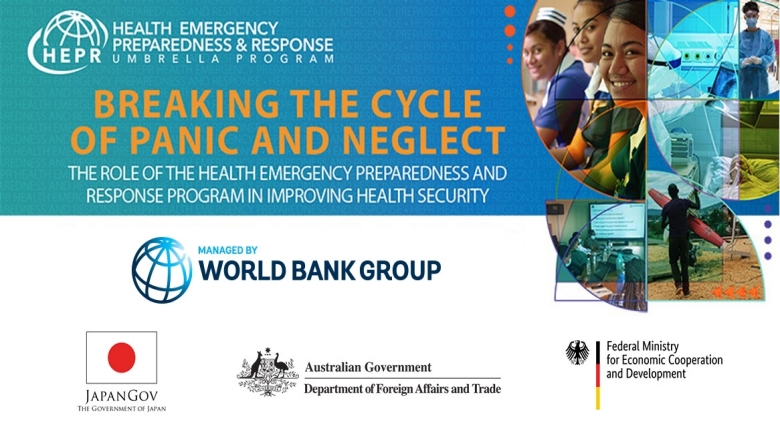We are meeting to discuss the issues of preparedness and response after more than two years of a global Pandemic. Although the situation has improved, we still need to be cautious given the case numbers in some countries and the low level of vaccination in some parts of the World.
The past two years have brought a lot of hardship: in terms lives lost, impacts on livelihoods and economic opportunities, and the impact on Human Capital through school closures and basic health services. This has further raised concerns about the state of preparedness of the world, and our collective ability to break the cycle of Panic and Neglect.
This is more urgent given what we know about the state of the world. In 2021, the Global Health Security Index showed the extent of the challenge with 70% of countries showed insufficient capacity to respond to health emergencies and deliver essential health services in clinics, hospitals, and community health centers. The pandemic revealed stark disparities in the capacity of countries to prevent and respond to COVID-19 bringing into sharp focus significant under-investments in pandemic preparedness which has amplified inequalities at all levels and highlighted the urgent need for collective action.
A recent Bank paper shows that most low- and middle-income countries are already facing tremendous fiscal pressures from the ongoing pandemic and will not be able to mobilize the huge sums necessary for investing in preparedness nor for strengthening their health systems.
To respond to these challenges the global community has shown a strong willingness to lean forward.
Indeed, the IDA20 replenishment, which was hosted by Japan, has culminated in a package which includes ambitious commitments to support countries to strengthen pandemic preparedness and response. The preparedness agenda is front and center of this IDA round.
The G20 and G7 have recently endorsed a new Financial Intermediary Fund (FIF) to strengthen preparedness and response. The FIF is meant to complement the current offerings and close remaining gaps in support of countries around the world.
Furthermore, there is broader and growing awareness of the One Health approach, which offers a framework to think about prevention and preparedness at country level. For instance, this is something that we are reflecting more and more in our World Bank portfolio through entry-points in the agriculture and environment sectors.
All of these efforts have to build on what we know works, and complement it in order to provide needed resources to countries who will have to address many gaps with limited fiscal space and competing needs. This requires collaboration and strong partnerships amongst all of us. No single actor or plan can do it alone.
This is where the Health Emergency Preparedness and Response Program is comes with its mission to catalyze, complement and connect. It has a critical role to play in the network of services and support we are building for our clients. I want here to thank Japan, Australia and Germany for their financing for and partnership in the HEPR program.
The HEPR Program has already allocated 29 grants, supporting 24 countries and territories, and three regional efforts. And the work underway truly is catalytic: filling key gaps and sparking innovation. For example:
- Building on the review by the Independent Evaluation Group on the effectiveness of regional efforts for COVID 19, the HEPR program has supported 3 regional grants: advancing One Health approaches in selected countries in East Asia and Pacific, improving cross-border coordination in the East Central and Southern Africa Health Community, and the genomic surveillance network in Africa.
- In Indonesia, the HEPR program is supporting one of the largest vaccines roll out efforts in the world.
- Reaching across sectors as in Zimbabwe where the HEPR Program and the Energy Sector Management Assistance Program (ESMAP) have banded together to support climate-friendly investments in health emergency preparedness; and connecting national and subnational levels as in Cambodia where HEPR Program assistance is strengthening vaccine storage and transportation capacity at both levels to create an effective, combined response.
And projects jump-staring innovation that could significantly improve capacities and connect the unconnected, including drone delivery in Timor Leste, and efforts supporting Syrian refugees and their host communities in Lebanon.
Today’s session provides a valuable forum to delve deeper into the progress made through the HEPR Program funded efforts since the it was approved 18 months ago and the work ahead. It also affords an important opportunity to hear from leaders on the frontlines in countries and communities – essential voices from whom we must all learn as we chart the way forward.
Before I hand over to the team, I would like to leave with two thoughts:
- First, we need to make strong analytical work at country and global levels a priority. Indeed, key indicators and analysis, as well as in depth work to understand country context will be important to guide policy and investments, but also raise the awareness on what is needed.
- Second, although there is a momentum now around the agenda of preparedness, this can be sidelined very quickly by other emerging priorities. I count on all partners here to help make sure we maintain the push, and that we all advocate for preparedness to be streamlined throughout all aspects of the recovery.
I look forward to listening to our many partners and friends gathered here today for this event, from the Ministers of Health of Eswatini, Guyana, Togo, and partners from Japan, Australia, WHO and the Africa Center of Excellence for Genomics of Infectious Diseases.
Thank you

